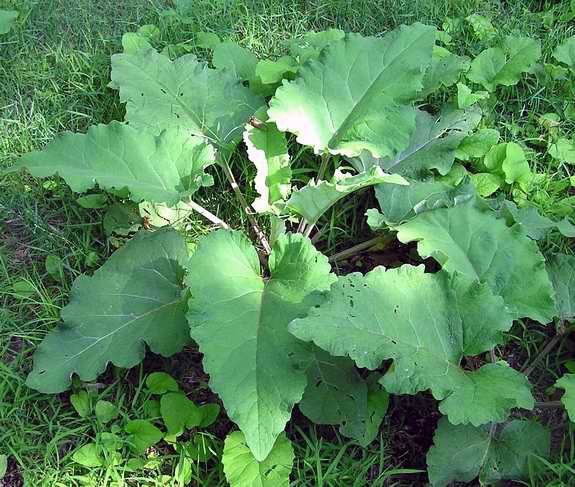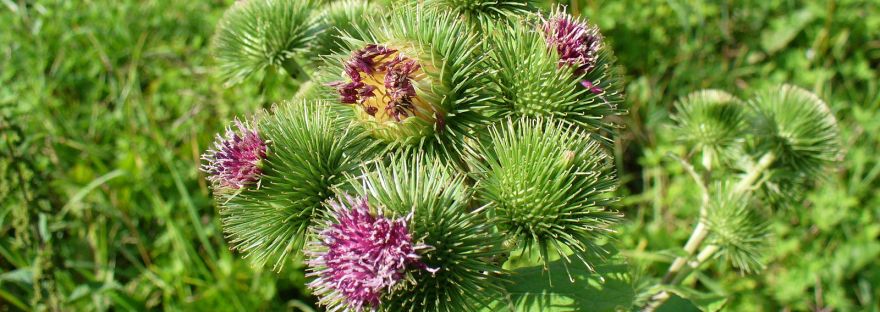The Burdock Plant
Summary:
This is Episode #11 and it is the fourth in my Plant Features!! Today, we are taking a look at the Burdock plant. This is a plant that grows freely and easily in many regions, it may be best known for its annoying burrs that seem to latch onto horse, dogs, and clothing, but it is an amazing plant, nonetheless! This podcast is a rundown of what the burdock plant is and how its useful to nature and to mankind.
In this Episode you’ll learn:
Scientific name for Burdock is Arctium and it is part of the Asteraceae family. It is native to Europe and Asia but has grown and has been introduced in other parts of the world.
Burdock has large, heart-shaped leaves and bright pink-red to purple thistle-like flowers. The large lower leaves make it good for clearing out excess weeds below it, and because it can grow fairly tall, with some plant varieties getting up to 9 feet tall, it can protect plants around it. IT can also be beneficial because of its long and deep tap root, which pulls minerals and nutrients up for plants at the surface.
Another distinguishing feature are the sticky burs that can stick to clothing or animal fur. The roots of The deep roots of the burdock plant are brownish-green or nearly black on the outside.

Burdock root has a ton of vitamins and minerals such as,
- dietary fiber
- vitamin B6
- manganese
- magnesium
- potassium
- folate
- vitamin C
- phosphorus
- calcium
- iron
- copper
Burdock grows in a natural PH and uses average water
As an interesting fun fact Burdock is responsible for “velcro” Swiss engineer George de Mestral was hiking in Switzerland and he and his dog’s fur became laden with burs. Upon examining them, he saw how they each have tiny hooks that clasp onto soft clothing or fur. He later patented velcro in 1955.
As for Burdock’s benefits to mankind,
Burdock can be used in many different ways.
- Burdock root is beneficial for the blood and lymphatic system. It is a powerful anti-bacterial and anti-inflammatory (which as we’ve discussed before, means that it can help with pain and healing various maladies to do with the circulatory, muscular, and dermal systems)
- The common cold or nasal congestion can be mitigated by burdock root. It is amazing for our respiratory system, and helping to relieve nasal pressure/coughing.
- Burdock has properties which have been seen to detoxify heavy metals, and it is a natural diuretic, which heightens its detoxifying properties. Because it is also a blood purifier or so good for the circulatory system it increases blood flow, and helps with acne, eczema, and psoriasis. Burdock also cleanses our lymph systems, which are essentially our waste systems. Typically lymph movement or rather lack there of, is one of the reasons cancer grows so prolifically. The more we can move and detox our lymph system, the better our organs will operate.
- Now of course, if we talk about the lymph system, we will soon be talking about cancer. And if your wondering, yes, burdock root has been seen to stop cancer cells from metastasizing, and therefore, is a viable cancer fighter. Research has found that a lignan called arctigenin which is found in burdock is able to produce apoptosis in lung adenocarcinoma cells.
- Burdock is also great at regulating blood pressure. It has high doses of potassium, which is a mineral that can improve high-blood pressure, and help regulate the cardiovascular system. Similarly it can manage diabetes and blood sugar levels.
- Burdock has also been used in women’s health as a plant to help balance hormones, and as a root that curbs menopause related symptoms. It has also been used to reduce the presence of wrinkles!
- Burdock has even been used to help heal leprosy!
According to Dr. Axe “Burdock root contains inulin, a soluble and prebiotic fiber that helps improve digestion and lower blood sugar, making it an excellent choice for people trying to naturally manage their blood sugar. In Europe, the fresh root is used for lowering blood sugar, its inulin content making it particularly suitable for diabetes. Animal studies have also shown burdock root’s ability to decrease the severity of diabetic complications, especially diabetic retinopathy. (7)” The inulin also helps create a healthy gut flora. As probiotics create food for healthy bacteria to grow.
Resources Mentioned/Used:
General Information on Researching Burdock
How to do a skin test for foraged plants:
Dr Axe Information on researching Burdock
Cancer study about how burdock properties cause apoptosis in cancer cells.
More information on the benefits of Burdock.

Recipes/How to Use:
As far as using Burdock, it can be used in 3 general ways.
- It can be eaten raw from the leaf/cooked as a vegetable
- It can be used as a root powder, or the root can be cooked as a vegetable.
- It can be made into an infused burdock root oil.

Root: Similar to Dandelion root tea which we talked about in episode 8, you can make tea out of burdock root or cook it similar to a vegetable. The root can grow up to 4 feet deep, and if you are growing the burdock mainly for the foot, you should trim leaves as it grows to ensure a thick root base.
The anti-inflammatory properties of Burdock also make it good for the liver and kidneys, our cleansing organs are aided by anti-inflammatories.
Spring Detox by Dr. Aviva Romm.
Root Veggie: In Japan burdock root is widely used as a vegetable. You can eat it raw/ You can stir-fry it or use it in green smoothies or cook it into soups.
Leaves: When eating the leaves fresh off The plant, they should be harvested when they are young and the size of spinach, for best flavor.
Burdock oil: Burdock as an extract is also a way to use Burdock. This is best for putting on the scalp or skin. Or breathing aromatically for respiratory aid.
In addition to being a great cure for skin problems, it is also good for hair loss and for preventing dandruff or dry scalp. For hair and skin issues it can be applied directly to the head or skin and taken internally. With the anti-inflammatory properties of Burdock it is good for rheumatoid arthritis. Burdock oil can also kill almost all type of funguses and bacteria. And it does this without harming our own immune system and cellls.
Burdock recipes for cancer fighting concoctions:
In fact According to Dr. Mercola, according to a study published in the International Journal of Rheumatic Diseases. Researchers noted that the plant helped lower inflammatory markers among patients with knee osteoarthritis.
*Special Note: Burdock is prolific and easy to find, however, it is a toxin accumulator, so if you are eating foraged burdock root, it is important to know the area you are foraging to make sure it is far away from any roads and in an area that has not been sprayed with any weed killers, pesticides or herbicides.
Another note of caution is that Burdock is a powerful plant, and if you are on any medications, specifically with blood sugar and blood pressure types, burdock could alter medication efficacy, so I will say this many times, please do not take this information as a diagnosis or as a health protocol. This is just information and history about plants, and for medical questions/concerns you need to contact your healthcare team.
Overall, Burdock burs have given burdock the reputation of being a petty weed, but if you can gather some leaves, or roots without being captured by nature’s velcro, you may be able to enjoy amazing health benefits for your hair, skin, cardiovascular system, lymph system, respiratory system, and so much more!
If you have some or find some on your property or while you are foraging, please take a picture and tag permacutlrue princess and hashtag #PermaculturePrincessPodcast & #plantfeatures



2 thoughts on “PPP 11: Burdock Benefits Beyond Burrs”